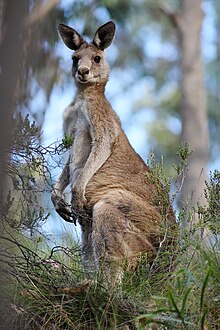Eastern grey kangaroo
| Eastern Grey Kangaroo[1] | |
|---|---|

| |
| Scientific classification | |
| Kingdom: | |
| Phylum: | |
| Class: | |
| Infraclass: | |
| Order: | |
| Family: | |
| Genus: | |
| Species: | M. giganteus
|
| Binomial name | |
| Macropus giganteus Shaw, 1790
| |
The Eastern Grey Kangaroo (Macropus giganteus) is a marsupial found in southern and eastern Australia, with a population of several million. It is also known as the Great Grey Kangaroo and the Forester Kangaroo. Although a big Eastern Grey male typically weighs around 66 kg (145 lb.) and stands almost 2 m (6 ft.) tall, the scientific name, Macropus giganteus (gigantic large-foot), is misleading, as the Red Kangaroo of the semi-arid inland is larger.
Description
The Eastern Grey is easy to recognise: its soft grey coat is distinctive, and it is usually found in moister, more fertile areas than the Red. Red Kangaroos, though sometimes grey-blue in colour, have a totally different face to Grey Kangaroos. Red Kangaroos have distinctive markings in black & white beside their muzzle and along the side of their face. Grey Kangaroos don't have these markings, and their eyes seem large & widely open. Where their ranges overlap, it is much more difficult to distinguish between Eastern-grey and Western-grey Kangaroos, which are closely related. They have a very similar body shape and facial structure, and their noses/muzzles are fully covered with fine hair (though that is not obvious at a distance, their noses do look noticeably different to the noses of Reds and Wallaroos). The Eastern-grey is a light-coloured grey or brownish-grey, with a lighter silver or cream, sometimes nearly white, belly. The Western-grey is a dark dusty brown, with more contrast especially around the head. [3] Indigenous Australian names include iyirrbir (Uw Oykangand and Uw Olkola) and kucha (Pakanh).[4]
-
Joey
-
Eastern Greys in native habitat
-
Adult male, Maria Island, Tasmania
Ecology
Although the Red is better known by reputation, the Eastern Grey is the species most commonly seen in the flesh: few Australians visit the arid interior of the continent, while many live in and around the major cities of the south and east coast, from where it is usually only a short drive to the remaining pockets of near-city bushland where roos can be found without much difficulty. It prefers open grassland with areas of bush for daytime shelter. Like all kangaroos, it is mainly nocturnal and crepuscular, and is mostly seen early in the morning, or as the light starts to fade in the evening.
In more remote areas, the Eastern Grey occurs in great numbers, and if left unchecked reaches plague proportions. From time to time shooters are employed to reduce its numbers, almost always to the accompaniment of a public outcry. Given the very limited amount of fodder in dry years, however, the only other choice is starvation.
Speed
The Eastern Grey Kangaroo can travel very fast over land. The highest ever recorded speed of any kangaroo was 64 kilometres per hour (40 miles per hour) set by a large female Eastern Grey Kangaroo.[5]
Status

It is often said[6] that kangaroo populations have increased significantly since the European colonisation of Australia because of the increased areas of grassland (as opposed to forest), the reduction in Dingo numbers, and the availability of artificial watering holes. The current estimated population of the species numbers two million.[7] Due to this, the Eastern Grey has begun to be culled in some parts of Australia [8]
While the Eastern Grey remains common, there are vast areas of country from which it has been exterminated (in general, it avoids humans), and most of the more fertile districts now carry crops or exotic pasture grasses which kangaroos tend not to eat. (One of the easiest ways to find kangaroos is to look for patches of remnant native grassland.)
References
- ^ Groves, C. P. (2005). Wilson, D. E.; Reeder, D. M. (eds.). Mammal Species of the World: A Taxonomic and Geographic Reference (3rd ed.). Baltimore: Johns Hopkins University Press. p. 64. ISBN 0-801-88221-4. OCLC 62265494.
- ^ Template:IUCN2008 Database entry includes justification for why this species is of least concern
- ^ Dawson, Terence J. (1998). Kangaroos: Biology of the Largest Marsupials. Sydney, Australia: University of New South Wales Press. pp. 12–18. ISBN 0-86840-317-2.
- ^ Hamilton, Philip. "Eastern grey kangaroo, Macropus giganteus". Oykangand and Olkola Dictionary. Retrieved 2007-02-03.
- ^ The Guinness Book of World Records. 2004. p. 53.
- ^ [1][2]
- ^ BBC - Science & Nature - Wildfacts - Eastern grey kangaroo
- ^ [3][4][5]




